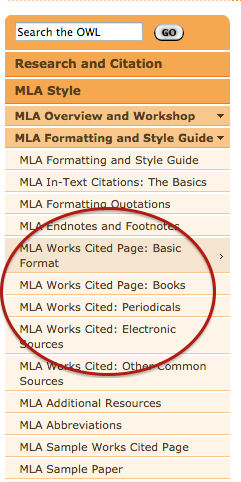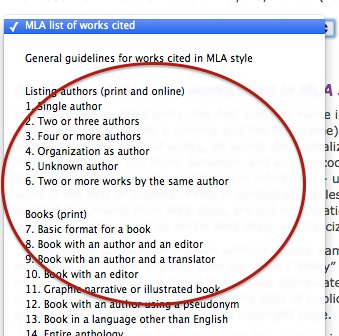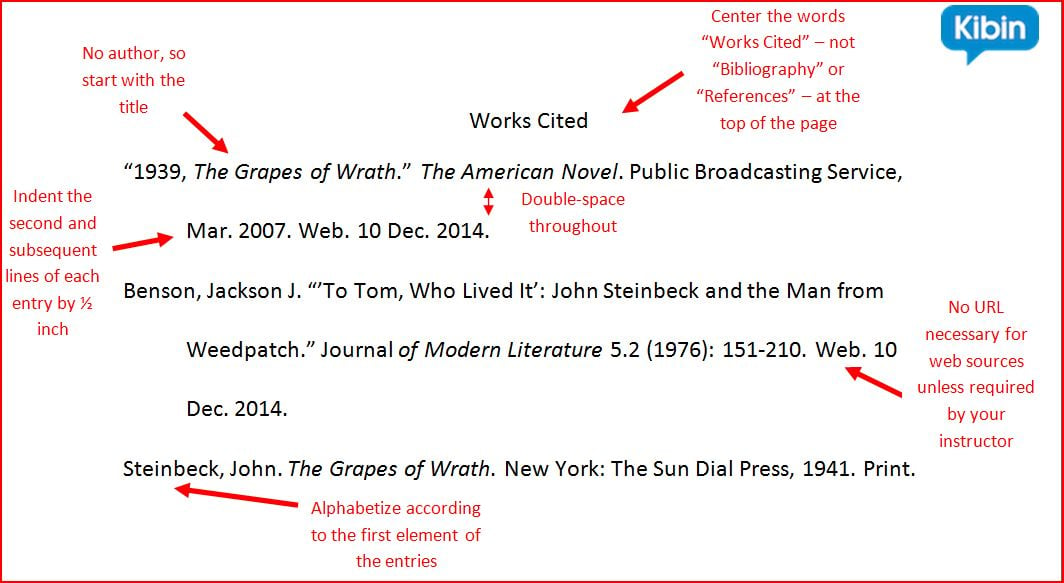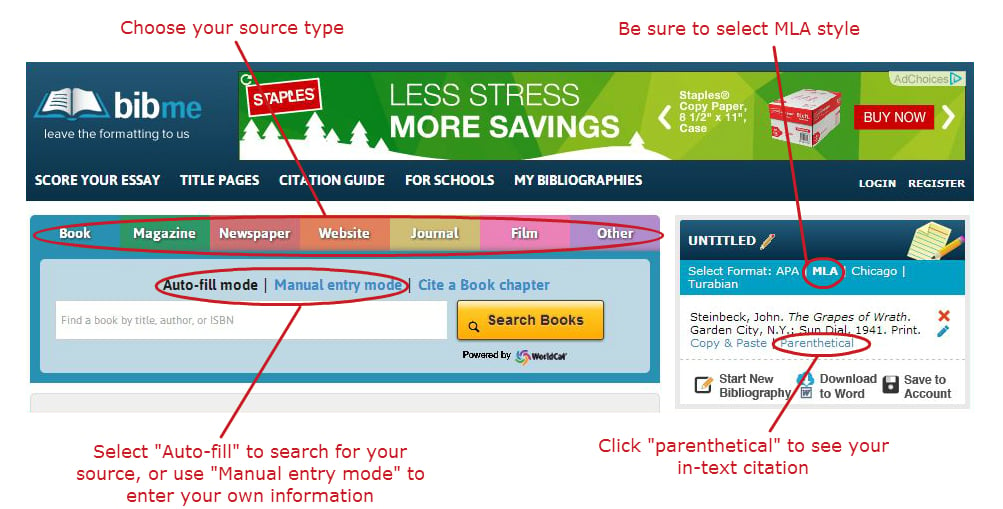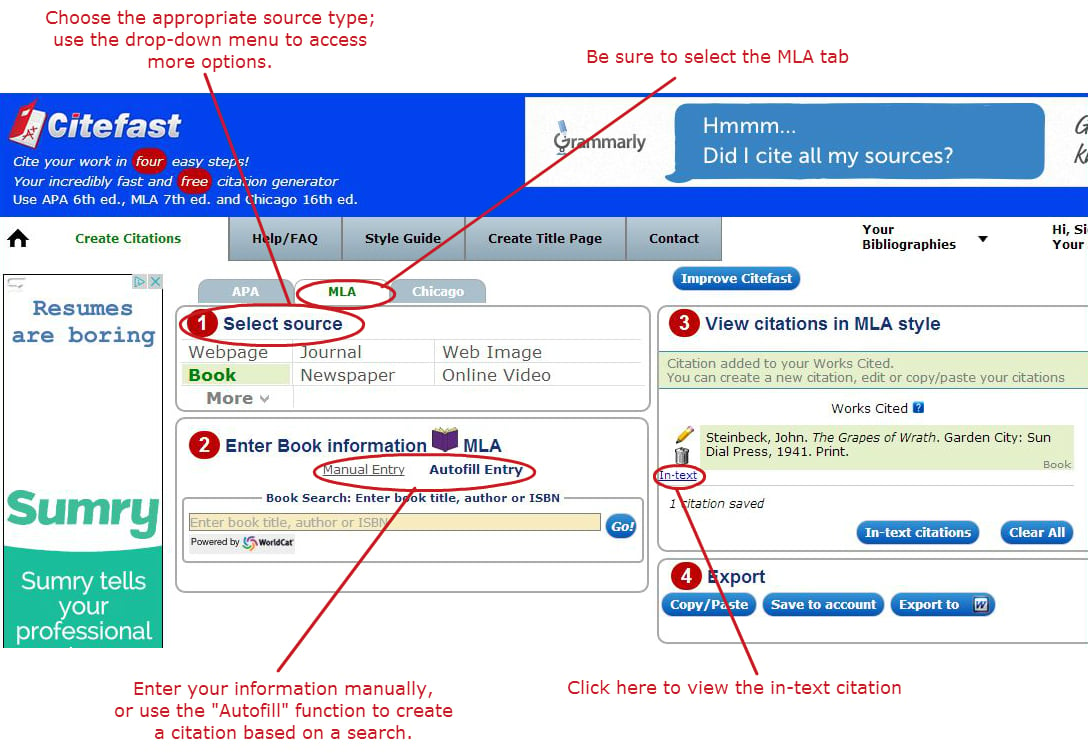“You’re bound to get idears if you go thinkin’ about stuff.” — Tom Joad in John Steinbeck’s The Grapes of Wrath
So you have to write a paper for your English class, and your teacher has asked you to include MLA citations for your sources. And maybe that freaks you out just a little (….or a lot).
Well then, you think. I just won’t use any sources and will instead rely on my own idears!
So you start thinkin’ about stuff, and you do have some great ideas. Then, you start to quote the book as support, and…oh. OH. You have to cite the book even if you don’t consult any other sources?
Yup. Sorry, Charlie!
And if you have to cite the book (or essay, or poem, or almost any other piece of literature you’re analyzing) anyway, what are three or four or fourteen more sources? Drawing on the expertise of other writers to support your ideas will only improve your odds of writing a killer paper (and getting a killer grade).
But you have to cite those sources.
Don’t let citation intimidation keep you from thinkin’ about stuff and giving the Joads (or any other subject) the treatment they deserve. Let me teach you how to write MLA citations (and your Works Cited, too!) in just four easy steps.
What are MLA Citations, and Who Uses Them?
A citation, at its heart, is like an address. Just as a postal address helps someone find a specific location, a proper citation helps a reader find a specific source.
So I can just paste the web address or title of a book in my paper, right? you might think.
Nope! You’ve got to be more specific. Pasting a book title or web address in your paper is like texting your friends a years-old picture of the trees and grass around you and expecting them to find the park where you’re waiting.
They might stumble upon you eventually, or they might show up to the wrong park altogether.
If you give your friends the address of the park, though, Siri or Google or the CIA can help them pinpoint your location in seconds.
Citations work the same way. If you give your readers the ‘address’ of the source, they can locate it quickly. Even more importantly, they can locate the right edition or version of the source to make sure page numbers match up, translations are the same, and so forth.
Just as the pieces of a postal address are arranged in a specific way, the pieces of a citation are, too. And just as every country has a slightly different format for postal addresses (see for yourself!), most disciplines — or subjects — have slightly different formats for citations.
So let’s talk about MLA citations, specifically, including who uses them and what “MLA” means, anyway.
MLA stands for “Modern Language Association,” which is a professional organization for teachers and scholars of language, literature, and the humanities.
This organization publishes its own handbook for formatting papers and — relevant to your interests — citing sources.
Many students first encounter MLA style in their high-school or college English classes, although students (and professionals) in other language, literature, and (some) humanities disciplines also use MLA.
Every MLA citation has two parts:
- the in-text citation, which appears after a sentence containing information from another source, and
- the Works Cited entry, which appears in the list of resources at the end of your paper (known as — spoiler alert — the Works Cited).
Why two parts?
The in-text citation is a form of shorthand that helps the reader find the longer entry (that contains much more information) in the Works Cited.
Going back to the directions analogy, it’s kind of like saying “the park on 4th and Main” so that your friends can find it on a map of your city. The in-text citation is more informal than a full address and includes less information, but it gives the reader enough context to find the entry in the Works Cited.
Now that you know what MLA citations are and why you need to use them, check out these four easy steps for writing your own citations.
Four Easy Steps for Writing MLA Citations
The process of citing your sources is much easier when you write both the in-text citation and the Works Cited entry at the same time. This way, you build your source list as you go, and you ensure that you don’t accidentally include in-text citations without associated entries in the Works Cited (which is a pretty frequent issue I encounter during editing).
With that in mind, you can knock out both parts of an MLA citation in just four easy steps.
Step 1. Decide what type of source you’re dealing with
When you’re writing a literary analysis or another type of research paper or essay, you might consult a pretty wide range of resources: books, articles in scholarly journals, web pages, and more.
In order to construct your citation, you need to determine exactly what kind of source you have. This is important because citing the Bible, for instance, is a little different from citing any other book, and citing a CD is a little different from citing an MP3.
Step 2. Find the appropriate structure/plug in information
Once you know what type of source you are citing, you should locate the correct structure for the Works Cited entry. There are loads of great places to look, including
1. The Purdue OWL’s Works Cited resources
2. The Bedford/St. Martin’s Research and Documentation online handbook
3. If you’re totally stuck on a hard-to-cite source, see if your library has a physical copy of or online subscription to the official MLA Handbook for Writers of Research Papers, which is the most comprehensive MLA resource available.
4. Sometimes our ways of accessing information change more quickly than the handbook is updated. For instance, the MLA doesn’t yet have guidelines for citing mobile apps, but Hans Mundahl at Ed Social Media has written a great blog post with 7 tips for citing apps using existing MLA guidelines.
To save you a little time, I’ll also share the structures for the most common sources you’re likely to encounter in your research.
Book
Last Name, First Name. Title of Book. Publishing location: Publisher, Year of Publication. Medium of publication.
Journal article
Last Name, First Name. “Title of Article in Title Case.” Title of Journal Volume.Issue (Year): Pages. Medium of publication.
Web page
Last Name, First Name. “Title of Web Page.” Title of Web Site. Name of publisher/sponsor of site, Date site was created. Medium of publication. Date of access.
After finding the right structure, you simply plug in the information from your source. It’s not so different from plugging in the different parts of an address, if you think about it.
Step 3. Add entry to Works Cited
Once you’ve plugged in your information, you’re ready to add the entry to your Works Cited page.
To give you an idea of what your Works Cited should look like as it comes together, I put together an example Works Cited that includes a book, a journal article, and a web page entry. I also added some handy-dandy annotations with tips for formatting your page.
Step 4. Write in-text citation
After you’ve added the entry to your Works Cited, all that’s left to do is write your in-text citation. Compared to the rest of these steps — which really weren’t so bad, were they? — this part is gravy.
First, remember that you need an in-text citation any time you quote, summarize, or paraphrase information from another source. (Not sure of the difference? Check out the Purdue OWL’s explanation.)
The in-text citation follows the quotation or paraphrased information immediately, before you even stick a period at the end of a sentence.
A basic in-text citation contains the author’s last name and the page number on which you found the information, which applies only if your source — a journal article, a book — has page numbers.
Let’s take a peek at a few examples.
Say you’re citing a line from The Grapes of Wrath by John Steinbeck, which you’ve already added to your Works Cited, of course. The in-text citation would come right after the quotation, and the ending punctuation comes after the citation:
“Their eyes were inward and quiet, and their eyes, too, were lucent in the evening, lucent in dusty faces” (Steinbeck 135).
Daaaang. That was easy!
Now, let’s pretend you’re paraphrasing from Jackson Benson’s journal article cited above:
Scholar Jackson Benson felt that the latter half of the novel’s dedication, “To Tom, who lived it,” made the novel seem more exciting as he assumed it was a reference to Tom Joad (151).
Hey, wait a minute, you might be thinking. Why are the name and page number separate?
This just gives you one more way to cite your information. In this case, identifying the author in the text of the sentence makes sense. And since we did so, you can include just the page number in the parenthetical citation. Neat, huh?
There’s one more important consideration: what about those sources without named authors, like the web page in the example Works Cited? In cases like these, your parenthetical citation starts with the first element of the Works Cited entry. In most cases, this will be the title of the source:
“The novel has an unusual structure: chapters that present historical and social information that led to the present situation (‘intercalary chapters’) are interspersed with chapters of narration that focus on specific characters and develop the plot” (“1939, The Grapes of Wrath”).
Notice that the citation not only lacks an author, but it also doesn’t include a page number; this is just fine since the web page doesn’t have them.
Additional Resources
It’s important to know how to write MLA citations and find their structures on your own, and with the tutorial above, you should be well on your way.
But while you’re learning the ropes (or just citing a ton of sources), there are a few handy automated citation builders that can make the process of writing citations faster and easier. You can even use them to verify that you’re on the right track as you create your own.
Bibme is one great citation generator — and it’s free! It has an easy-to-use interface that allows you to create a citation based on a search, or you can enter your information manually. If you’re citing a source with many different editions and publishers, such as a 75-year-old novel, it’s best to use the manual entry mode.
Citefast is another free citation generator. You select your source type, enter/search for your source information, view your generated citations and then export or copy/paste them into your Works Cited. Like Bibme, Citefast provides the option to search for your source or enter the information manually.
As you can see in the screen grabs above, both of these generators also generate in-text citations for you, too; you have to add the page number, though!
Last but not least, you can test your smarts by playing ten rounds of MLA Master Blaster, a fun citation game from Williams College Libraries.
I hope you’re feeling pretty confident in your ability to write MLA citations. Don’t forget to have a Kibin editor check your work and help you put the final polish on your paper.
Happy writing!

